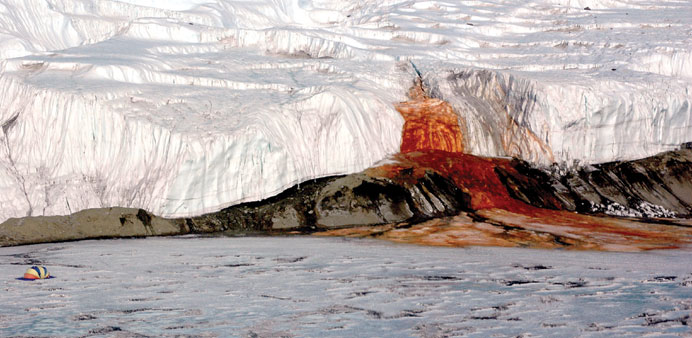RED ON WHITE: The Blood Falls seeps from the end of the Taylor Glacier into Lake Bonney. Photo: National Science Foundation/Peter Rejcek
Steff Gaulter
There are often stories in the news about Antarctica. It may be reported that an ice cap is melting, or that the extent of sea ice is growing, or perhaps there’s a new discovery deep beneath its icy surface. Whatever the story, the accompanying images are always of white pristine landscapes, interspersed by icebergs and the occasional penguin, but the intriguing thing is that not all of Antarctica is covered in ice.
The common perception of Antarctica being a place where it snows every day, doesn’t quite tie in with reality. It snows so little that Antarctica is officially classed as a desert. In fact it’s more rare to see snow falling in Antarctica than it is to see rain in Chile’s Atacama desert.
At first it might seem illogical that a place which we generally think of as a winter wonderland can be classed as a desert, but the definition of a desert is somewhere that receives less than 250mm (10 inches) of rain or snow a year. Antarctica certainly fits that bill, and can thank this lack of precipitation to its position on the globe. Cold air is very dense and heavy, and therefore generally will sink. Over the Poles, which are the coldest parts of the globe, the air in the atmosphere generally descends towards the earth. This sinking air is very dry, so suppresses any showers which might form and ensures that skies stay blue for the majority of the year.
Despite this lack of precipitation, it is true that the majority of the country is a frigid icy landscape. That’s because the snow and ice that are on the ground have been on the earth for many years. They never melt, instead they simply accumulate, forming large thick sheets of ice. However, there is one region in the continent which has seen absolutely no snow for nearly two million years and this is a place that is so dry that there isn’t even any ice lying on the ground.
This ice-free area is known as the Dry Valleys and it covers about 4,800 square kilometres (1,800 square miles). It contains almost no water, ice or snow, and is an arid expanse of dirt, small rocks and large boulders. High mountains on each side of the valleys prevent the glaciers seeping into the area, and the winds which whistle down the valleys at over 300 kph (180 mph) are so dry that any moisture instantly evaporates.
This exceptionally dry climate means that everything in the Dry Valleys is perfectly preserved. This allows scientists the rare chance to study fossils which are millions of years old. There are only a few places in the world which have this property, another being the Atacama Desert, which is where scientists unearthed fossils of giant penguins. These creatures, the size of a small person, date back 35 million years, yet their fossils remain thanks to the extremely arid air.
Strangely it has now been discovered that although the surface of Antarctica’s Dry Valleys is extremely dry, below ground there is a vast network of lakes which are teaming with life.
The clue to the existence of these groundwater lakes was a waterfall which seeps through a crack in the glacier at the southernmost tip of the Valleys. It’s a sporadic feature, but when it flows it is certainly eye catching; the waterfall is nearly five stories high and the water is a shocking red colour. It’s this unusual colour which led to it being given the rather sinister name of Blood Falls.
Using an electromagnetic sensor, a helicopter mapped the underground lakes and revealed the true extent of the network of water. The saltwater lakes stretch at least 12 kilometres (7.5 miles) inland, and to a depth of 350 metres (over 1,150 ft). Although it’s below freezing, it’s believed to be within the range that is tolerated by microbial life, and it’s this life which gives the Blood Falls their distinctive colour.
You may be wondering why you should care about the lakes underneath Antartica, a continent that most of us will never visit, but the content of the water is very intriguing. Despite the presence of at least 17 different types of microbes, the water contains almost no oxygen. It seems that life under the Valleys has somehow managed to exist for 2 million years without sunlight or oxygen.
Analysing the contents of the red water, scientists believe that the organisms are using sulphate as a catalyst to enable them to ‘breathe’ with ferric iron. This has never been seen before in nature, but could indicate that life could exist in places which were previously thought impossible. The cold, vegetation-free Dry Valleys are the closest conditions we have to a Martian environment, if there is life under these Valleys then it could be possible for life to exist on Mars.

